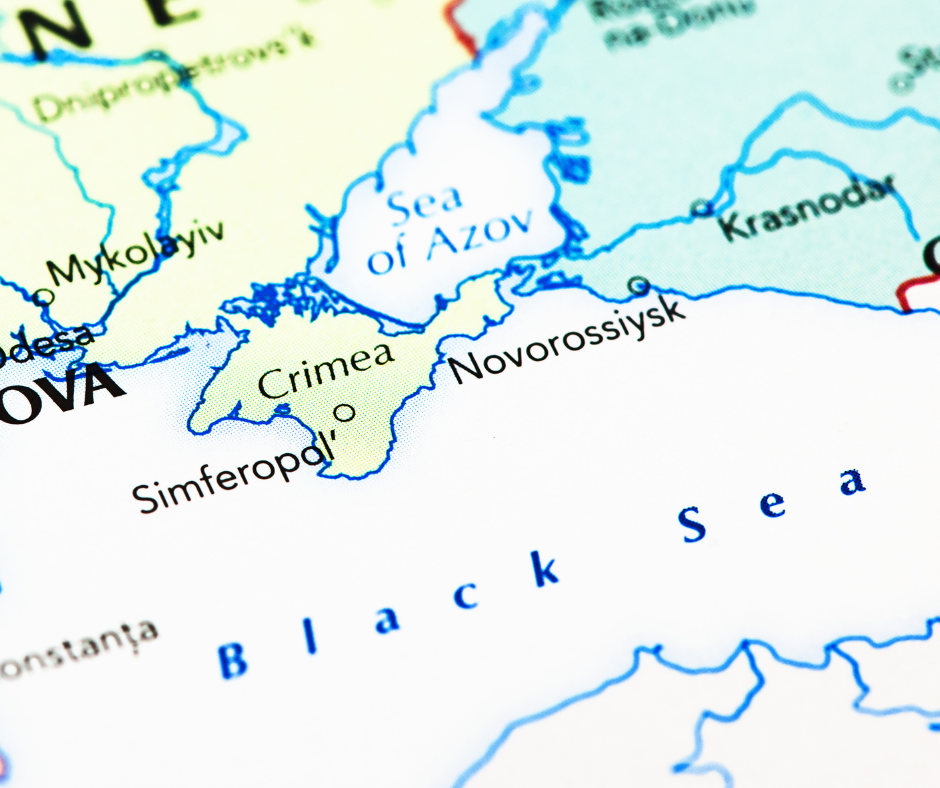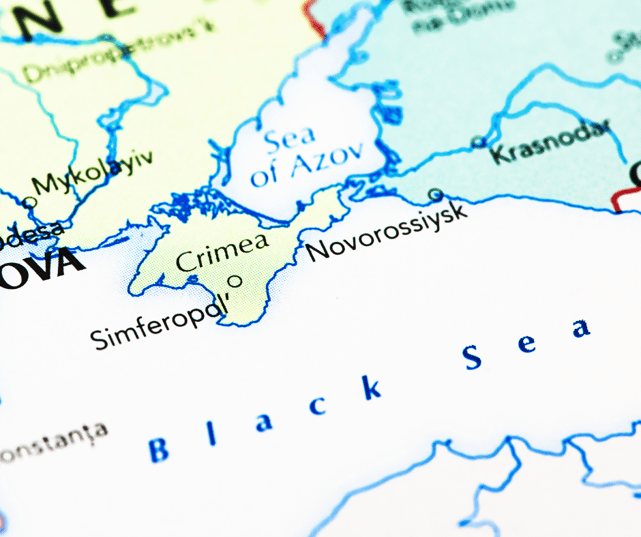
In “The Grand Chessboard” (1997), the political scientist Zbigniew Brzezinski was among the first to predict that the Crimean Peninsula would be an important factor for instability in the territories of the former Soviet Union.

Indeed, the status of Crimea has since become one of the central elements in Russia’s all-out attempt to maintain and expand its imperial position.
In his so-called Crimean speech, delivered at the Kremlin in 2014, Russian President Vladimir Putin announced the annexation of the peninsula. To justify Russian rule in Crimea, he recalled that the baptism of St. Vladimir, the ruler of Kyivan Rus, took place in Khersones, on the southeastern edge of Crimea, before he later accepted Christianity for all of Rus in Kyiv in 988. Mr. Putin’s claim was historically preposterous; the ancient city was a former Greek colony in the time of St. Vladimir and has nothing to do with today’s Russia. Like the “baptism of Rus” in Kyiv, it was unrelated to the birth of the Grand Duchy of Moscow that gave rise to imperial Russia.
Crimea’s winding history
President Putin was simply repeating the story of the “Russian Crimea,” one of the most successful lies spread by Russian propaganda. In reality, Crimea has changed hands many times, falling under Russian rule for a relatively short time.
In the late Middle Ages and early modern period, Crimea became the main center of the Crimean Khanate. In 1774, with the Ottoman Empire’s defeat to Russia in the Russo-Turkish War, both parties signed the Treaty of Kucuk Kaynarca. The Ottomans relinquished their authority over the Crimean Khanate, which formally became independent for nine years before being annexed in 1783 by Catherine the Great. The khan resigned from his office, and the entire peninsula came under the rule of the Russian Empire.
The 1783 annexation of Crimea took place around the same era that the empire took Bialystok, Warsaw and Tbilisi – belying any “eternal” Russian claim to the peninsula. Quite simply, in the mid-19th century, Crimea was the subject of a conflict for dominance in the Black Sea basin. Russia felt confident at the time and certainly posed a threat to the Ottoman Empire; from the perspective of Moscow, owning Crimea was like opening a geopolitical window to the south, and from there to the whole world. Without it, Russia only had access to the globe’s northern waters, which froze in winter.
The decisive playing field for rule over Crimea in the 19th century was the Crimean War. This time, the Ottomans received the support of France and the United Kingdom. The newly invented telegraph gave a technological advantage to the Turkish side. Meanwhile, the Russian military defense of Sevastopol would become an important national legend, and a founding myth of Russia as a superpower.
After World War I, as the old imperial structures were falling apart, Crimea was already on the map as part of Ukraine, during the reign of Hetman Pavlo Skoropadski. Given its geographical proximity, Crimea fell to Ukraine’s share in the inheritance of the Empire. A Ukrainian republic was recognized in this form by Western governments, including Germany. By 1921, however, it became part of the Soviet Union, as did Crimea, as an autonomous republic.
In 1954, Soviet leader Nikita Khrushchev transferred the peninsula to the Ukrainian Socialist Soviet Republic. At the time, practical and logistic pretexts were given, such as the supply of water. In the background, amid a quiet rivalry between the Soviet republics, Khrushchev sided with Ukraine, where he was raised and later served as General Secretary of the Communist Party.
From the end of the 18th century, throughout the period of the Romanov Empire and the USSR, Crimea was settled by Russians, and during Soviet times also by Ukrainians, especially after 1954.
When the Soviet Union disintegrated in 1991 along the borders of its existing republics, Crimea remained part of Ukraine. This was a crucial moment for the peninsula’s contemporary legal situation: its status as Ukrainian was historically justified and the logical result of a chain of events, culminating with the collapse of the empire. This fact has not been seriously disputed, and from 1991 to 2014 the Russian Federation recognized the borders of Ukraine with Crimea.
Strategic importance
Historically, Crimea was important because it provided a unique strategic position on the Black Sea. That has not changed; even today, Crimea is like an unsinkable aircraft carrier.
Domination on the peninsula enables a measure of control throughout the sea and indirectly in the territories surrounding it. In the 18th and 19th centuries, Russia competed for Crimea with Turkey, as there were no other players around the Black Sea. Today that picture has changed, with Georgia, Ukraine, Romania and Bulgaria also having access.
After the collapse of the USSR, Moscow sought to guarantee its influence in the Black Sea basin through an agreement with Kyiv, a deal that regulated the presence of the Russian Black Sea Fleet. It created a kind of special status for Sevastopol in Ukrainian Crimea, giving Russia the opportunity to operate strategically at sea. The last extension of the agreement by Ukrainian President Viktor Yanukovych, in 2010, was criticized at home by the opposition.
Crimea within Ukraine
Due to its specific nature, the Crimean Peninsula was granted autonomy within the Ukrainian state in 1992, helping to blunt separatist demands to join Russia. The status of the Autonomous Republic of Crimea is guaranteed in the Constitution of Ukraine. The most important body of Crimea became the 100-member unicameral parliament (the Verkhovna Rada of the Autonomous Republic of Crimea), which appointed the government and the prime minister. The powers of the republic primarily governed social and economic matters, tourism, and so forth.
With a free Ukraine, the Tatars – who were expelled from the peninsula by Stalin during World War II – returned to Crimea. Some Russians and in smaller numbers Ukrainians joined them. If Crimea has always belonged to anyone, it is to the Tatars, who now constitute just 12 percent of its 2.4 million residents. Ethnic Russians comprise a solid majority, though this does not mean that they are in favor of joining Russia. Indeed, their local “Crimean identity” may play a positive role in the peninsula’s future development.
The Tatars were given their rights under the conditions of a free Ukraine. They also established representation in the form of the Mejlis, a kind of parliamentary body, which later moved to Kyiv after the 2014 annexation.
However, Ukraine did not pay enough attention to Crimea after the collapse of the Soviet Union. “Orange” supporters believed that they had nothing to fear, since the peninsula’s status was ensured by the Budapest Memorandum, guaranteed by the United States and the UK, under the principle of Ukraine’s territorial integrity. But elections were often won by more pro-Russian parties, such as the Party of Regions, and other groups came to ignore the peninsula. It was also treated as a de facto obligation of the local authorities, not the federal government.
At the Yalta European Strategy forum, also in Crimea, a large international conference devoted to “Ukraine’s European future” was established by Viktor Pinchuk, a wealthy Ukrainian. Deliberations took place at Yalta’s Livadia Palace, the one-time summer retreat of Tsar Nicholas II that brought the peninsula international fame by hosting Stalin, Roosevelt and Churchill for a postwar summit.
Every year, a galaxy of well-known Western politicians from the European Union and the U.S. came to Crimea. The site for a conference on Ukraine’s European integration was symbolic: where Central Europe was once separated from the West, ties with the West were to be reconstructed.
2014 annexation
In occupying Crimea, Russia took advantage of just a few days of weakness of the Ukrainian state after the fleeing of former President Yanukovych, who was responsible for the attempt to suppress the Revolution of Dignity by force in 2014. The Kremlin subsequently held a false referendum under pressure, which purported to show that the majority of Crimeans wanted to join Russia.
In the eyes of the world, international law was violated as the Russians forcibly changed borders. This was not the first such case in the post-Soviet period; in 2008, for example, Moscow occupied part of Georgia. But the seizure of Crimea was the most spectacular, given the importance of the peninsula.
Despite this, Western reaction was inadequate and muted. Notably, even Turkey showed restraint, notwithstanding that Russia’s actions seriously damaged its strategic interests. One recalls the relatively tepid reaction to Hitler’s Anschluss of Austria.
As for the inhabitants of Crimea in 2014, resistance against Russia was not widespread, especially when compared to the Ukrainian fight against the Russian invasion after February 24, 2022.
The factors that allowed Russia to occupy the peninsula practically without fighting were complex: the makeup of the Crimean population, the weakness of Ukraine’s army, the presence of Russia’s Black Sea Fleet, political chaos in Kyiv. Years before 2014, there was talk of Ukrainian soldiers joining the Russian fleet (interestingly, the command did not treat it as a betrayal). However, Ukraine faced pressure from Western allies not to make any “nervous moves” in the area. To this day, rumors circulate in Kyiv’s political corridors that, for example, American politicians urged then-acting president Oleksandr Turchynov to take no further action in defense of Crimea. Only a few Ukrainian politicians bothered to visit the peninsula to demonstrate its connection with Ukraine.
After 2014, the Tatar population proved to be very loyal to Ukraine, with many temporarily moving to Kyiv and elsewhere in the country. Russia in Crimea took up a brutal policy against its intellectual elite and social leaders. However, Moscow was not able to ensure its development without a connection to the Russian mainland.
Its largest investment in Crimea is the bridge over the Kerch Strait, built by the Kremlin after the annexation, which connects the peninsula with Russian territory. In the telling of Russian propaganda, the bridge is one of the most important symbols of Crimea’s return to Russia – explaining why the bridge was attacked, and probably partly destroyed, by Ukraine in October 2022.
Source: GIS
Related Posts
Kenya receives ‘simulator’ to fight maritime crime
The fight against maritime crimes has received a boost following a partnership between the US and..
Did Russia commit a war crime in leaving the..
On July 17, Russia announced that it had withdrawn from the Black Sea Grain Initiative (“the..
UNODC, EU pledge support to Nigeria, others over..
The European Union (EU) and the United Nations Office on Drugs and Crime (UNODC) have pledged their..




